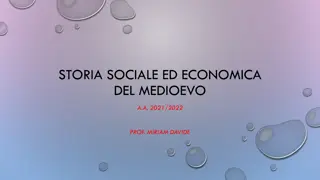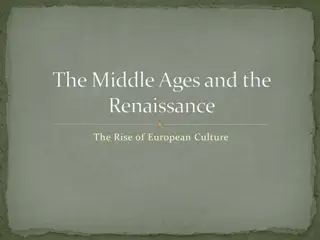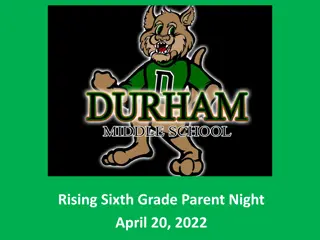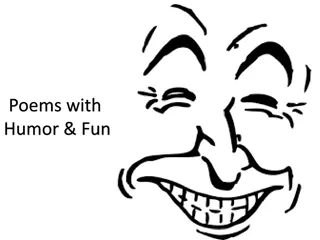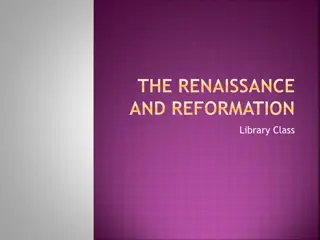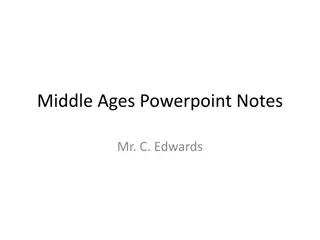Discover the Fun of Writing Limericks in the Middle Ages!
Explore the origin and characteristics of limericks popular in the Middle Ages, learn how to write limericks, and enjoy sample limericks. Engage in a fun interactive session to create your own silly limerick using the guidelines provided.
Download Presentation

Please find below an Image/Link to download the presentation.
The content on the website is provided AS IS for your information and personal use only. It may not be sold, licensed, or shared on other websites without obtaining consent from the author.If you encounter any issues during the download, it is possible that the publisher has removed the file from their server.
You are allowed to download the files provided on this website for personal or commercial use, subject to the condition that they are used lawfully. All files are the property of their respective owners.
The content on the website is provided AS IS for your information and personal use only. It may not be sold, licensed, or shared on other websites without obtaining consent from the author.
E N D
Presentation Transcript
LIMERICKS IN THE MIDDLE AGES! A limerick is a non-sense poem popular during the middle ages. Although no one knows for sure, the limerick form is thought to have germinated in France during the Middle Ages, after which it crossed the English Channel. Limericks were short and easily remembered. One did not have to know how to read or write to enjoy a limerick. The humor and easy creation of limericks infused oral poetry across class-lines. They were also ways to spread ideas and information to an illiterate population. Limericks have been used in everything from Shakespeare to nursery rhymes. Yet it wasn t until the early 1700s that soldiers returning from the continent-wide War of the Spanish Succession brought the limerick form to Ireland. In 1776, it appeared in published form in Mother Goose s Melodies; 25 years later, when Mother Goose nursery rhymes attained fame, the limerick was forever affixed to children s literature.
WRITING LIMERICKS A LIMERICK IS A SILLY, FIVE LINE POEM. THE FIRST, SECONDANDFIFTHLINES RHYME WITH EACH OTHER AND HAVE THE SAME NUMBER OF SYLLABLES (TYPICALLY 7 TO 10). THE THIRDANDFOURTHLINES RHYME WITH EACH OTHER AND HAVE THE SAME NUMBER OF SYLLABLES (TYPICALLY 5-7) LIMERICKS OFTEN OFTEN START WITH THE LINE "THERE ONCE WAS A_________FROM __________" OR I ONCE MET A __________CALLED __________ A (7-10 SYLLABLES) A (7-10 SYLLABLES) B (5-7 SYLLABLES) B (5-7 SYLLABLES A (7-10 SYLLABLES)
SAMPLE LIMERICKS Hickory Dickory Dock The mouse ran up the clock. When the clock struck one, Down he did run. Hickory Dickory Dock. There once was a woman named Grace, Who wore chocolate all over her face. When asked Why that s so, she replIed, don t you knoW? I can t fInd a toWel any place!
lets try one TOGETHER!! THERE ONCE WAS A GIRL NAMED MEG. WHO ACCIDENTALLY BROKE HER LEFT __________. SHE SLIPPED ON THE ________. NOT ONCE, BUT TWICE! TAKE NO PITY ON HER, I _________. A A B B A
YOU MAY WANT TO START BY MAKING A LIST OF WORDS THAT RHYME WITH A WORD YOU WANT TO USE. PAM (IS MY WORD) COMMON RHYMES FOR PAM ARE: BAM, LAMB, RAM, TAM, SLAM, CLAM, HAM, GLAM, SCRAM, JAM, YAM NOW, START WITH A COMMON PHRASE OR CREATE ONE OF YOUR OWN. THERE ONCE WAS A LADY NAMED PAM WHO LOVED THE TASTE OF HAM! SHE WOULD FILL HER TUMMY, ON ALL THINGS YUMMY, BUT NEVER DEVELOPED A TASTE FOR LAMB. There once was a teacher named Pam Who wore clothes made of wool from a lamb. She wrapped a scarf round her shoulder, As the temperatures grew colder, And she always looked very glam.
Now, create your own silly limerick using your name! Of course you will draw a cartoon to illustrate : )
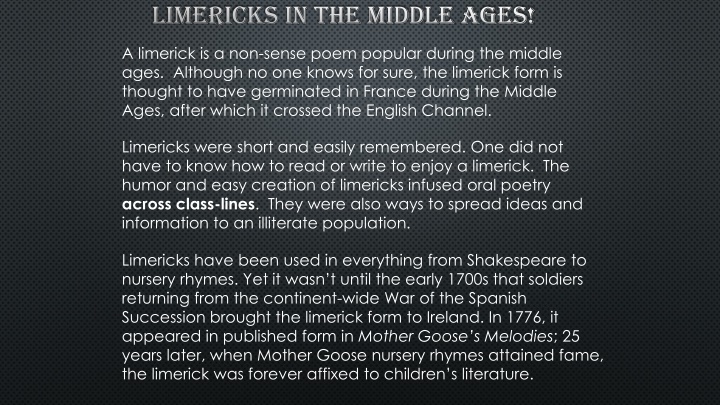

![READ⚡[PDF]✔ European Mail Armour: Ringed Battle Shirts from the Iron Age, Roman](/thumb/20552/read-pdf-european-mail-armour-ringed-battle-shirts-from-the-iron-age-roman.jpg)
